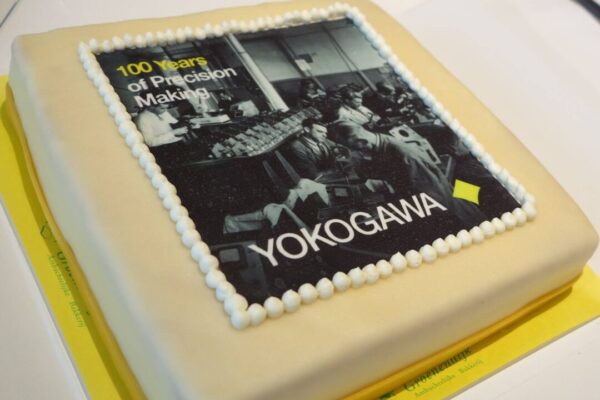
Calibration reveals order of magnitude better accuracy, says Yokogawa
Running an in-house power calibration lab is not new per se, admitted the company’s Vice President Terry Marrinan, Yokogawa and its competitors have been doing this for many years for their customers.
"Five years ago, we started discussing the possibility to get accredited to the ISO17025 standard, it required new equipment for our lab but it would strengthen our position as the undisputed authority in power measurement", Marrinan told us, highlighting that the company already had over 60% of market share in the bench top power meter business.
"Many companies provides power meters with high power measurement bandwidths well above 50/60 Hz, but even if the power accuracy for their measurement conditions is clearly specified, where is the proof?" asked Marrinan.
Later, Erik Kroon, Manager of Yokogawa’s European Standards Laboratory embarked himself and his team in a three-and-a-half years journey to accreditation.
"There are other labs offering calibration services, but what we’ve heard from customers is that other labs often let them behind, calibration at 50/60Hz is not enough. We are going to specialize ourselves calibrating electrical power from DC to AC, and from 10Hz to 100kHz while still being able to offer extreme accurate calibration around 50 to 60Hz, even at a low power factor of 0.0001 and at high currents".

The efforts paid off. The company has become the world’s first non-governmental facility to receive full ISO17025 accreditation for power measurements at up to 100kHz. We then learned that it is also working on MHz range power meter calibration.
This accreditation addresses the growing demand to remove uncertainty in power measurements, particularly with the growing focus on renewable energy markets and the need to optimise energy efficiency while complying with international standards on power quality, especially at low power factors.
In addition, the inverters used in renewable energy systems are switching at higher speeds: a scenario that introduces harmonics at higher frequencies.
There is also a demand for high-frequency power measurements on devices such as switch-mode power supplies, electronic lighting ballasts, soft starters in motor controls and frequency converters in traction applications.
"The recognition offered by ISO17025 accreditation is an objective proof that the knowledge of our personnel and the quality of our instruments are at a world-class level", said Marrinan.
The accreditation is particularly critical for customers working with tight tolerances. In fact, Kroon revealed that often by having their instrument calibrated, Yokogawa’s customers could benefit from a much more accurate instrument than originally specified on the spread sheets at factory level.
"Typically, we reveal an accuracy eight to ten times that of our specifications, sometimes we can offer a 20 fold increase in precision", said Kroon.
So why not make the claim directly on the datasheets as you sell the instruments? We asked.
"Because we are very conservative about our specifications" said Marrinan. "Yokogawa is recognized for the precision and stability of its instruments, and our philosophy is, ‘don’t go near the margins’. That way we can be confident our instruments will always operate within the marketed specs. But the proof of stability is in calibration, and as a side benefit, our customers get much better visibility about the actual accuracy and stability of their instrument so they can push their own measurement further".
Saying that, Marrinan emphasized this conservative approach didn’t prevent Yokogawa from ensuring best-class measurement capabilities even for its factory-set instruments.
From around 600 Euros for a simple power meter up to 4000 Euros for calibrating the company’s WT3000E, the most accurate precision power analyzer in the world, often the cost of calibration is marginal compared to the initial purchase price, noted Marrinan, but the service is priced so as to apply mostly to the low-volume high-end equipment.
For now, the lab wouldn’t be able to address high volumes, but it may be expanded if the calibration service ever becomes popular.
The lab runs automated calibration tests 24/7, with test routines spanning up to ten hours for the most sophisticated instruments. Each calibration runs across hundreds of calibration points, with roughly 40 measurements per calibration point.
The specially designed room is temperature controlled at 23ºC ±1ºC and has backup generators so as to function independently from the rest of the floor.
"So what are the costs and risks of not calibrating?" Asked Kroon to summarize his presentation and as a hook for the newly ISO17025 accredited service.
Working with tighter accuracy limits can prevent false passes or false failures during production or acceptance tests, but sometimes, the accreditation is a contractual requirement that customers want to secure, he said.
The calibration lab will double as an internal development tool, enabling the company to ensure that its new products will have undergone the most rigorous compliance testing and certification before release. Yokogawa’s customers can also be totally confident that they also have easy access to accredited traceable power calibration for all their needs, avoiding time-consuming submission to national standards laboratories.
Visit Yokogawa at tmi.yokogawa.com
 If you enjoyed this article, you will like the following ones: don't miss them by subscribing to :
eeNews on Google News
If you enjoyed this article, you will like the following ones: don't miss them by subscribing to :
eeNews on Google News



